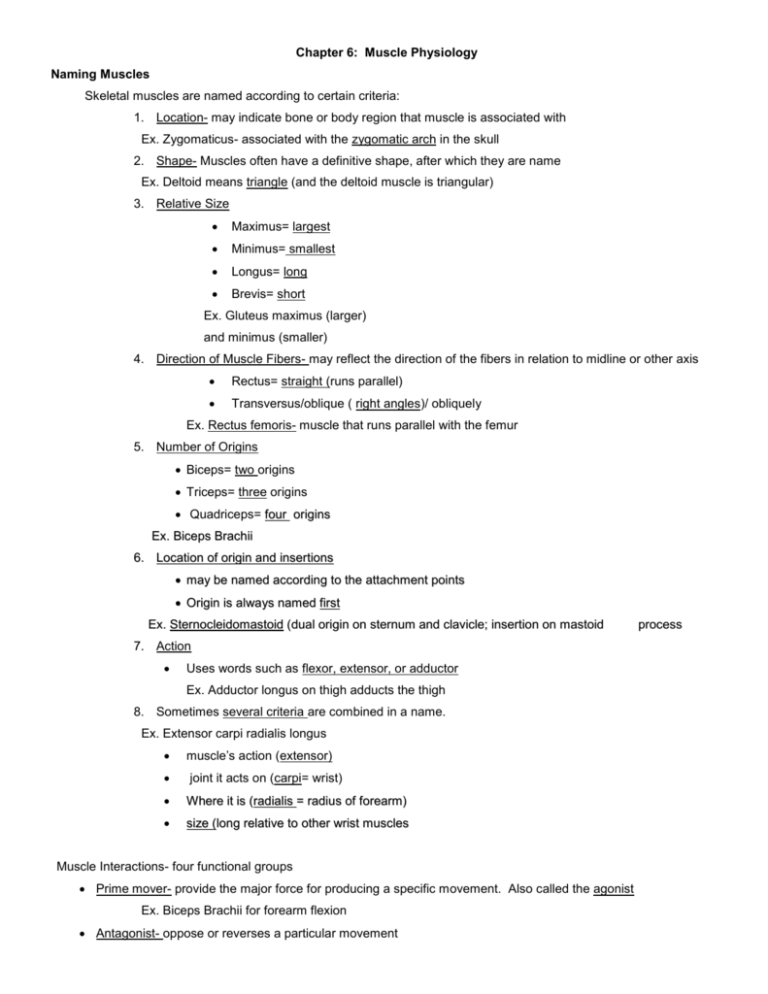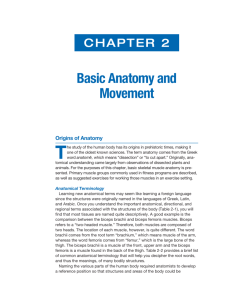Chapter 6: Muscle Physiology
advertisement

Chapter 6: Muscle Physiology Naming Muscles Skeletal muscles are named according to certain criteria: 1. Location- may indicate bone or body region that muscle is associated with Ex. Zygomaticus- associated with the zygomatic arch in the skull 2. Shape- Muscles often have a definitive shape, after which they are name Ex. Deltoid means triangle (and the deltoid muscle is triangular) 3. Relative Size Maximus= largest Minimus= smallest Longus= long Brevis= short Ex. Gluteus maximus (larger) and minimus (smaller) 4. Direction of Muscle Fibers- may reflect the direction of the fibers in relation to midline or other axis Rectus= straight (runs parallel) Transversus/oblique ( right angles)/ obliquely Ex. Rectus femoris- muscle that runs parallel with the femur 5. Number of Origins Biceps= two origins Triceps= three origins Quadriceps= four origins Ex. Biceps Brachii 6. Location of origin and insertions may be named according to the attachment points Origin is always named first Ex. Sternocleidomastoid (dual origin on sternum and clavicle; insertion on mastoid 7. Action Uses words such as flexor, extensor, or adductor Ex. Adductor longus on thigh adducts the thigh 8. Sometimes several criteria are combined in a name. Ex. Extensor carpi radialis longus muscle’s action (extensor) joint it acts on (carpi= wrist) W here it is (radialis = radius of forearm) size (long relative to other wrist muscles Muscle Interactions- four functional groups Prime mover- provide the major force for producing a specific movement. Also called the agonist Ex. Biceps Brachii for forearm flexion Antagonist- oppose or reverses a particular movement process Ex. Triceps brachii for forearm extension (oppose biceps) synergist- aid agonist (prime movers) by promoting the same movement orreducing undesireable or unnecessary movements that might occur as the prime mover contracts. Ex. Semimembranosis helps the biceps femoris with thighextension and knee flexion Fixators- a synergist that immobilizes or stabilizes a bone or a muscle’s origin Ex. Rotator cuff muscles (terest minor, infraspinatus, supraspinatus, subscapularis) Example of movement of all four involved in a movement 1. prime mover= pectoralis major (shoulder flexion) 2. antagonist= lattisimus dorsi 3. synergist= biceps brachii 4. fixator= rotator cuff Muscle Movements Muscles move toward their origin from the insertion of the muscle. Origin is the bone point that does not move and the insertion is the bone attachment that does move. Ex. Origin- sternum and clavicle Insertion- mastoid Muscle when it contracts pulls the mastoid (skull) down toward the sternum and clavicle (bringing your head toward your chest) Flexion- bending movement that brings two articulating bones closer together. Extension- reverse of flexion, moves the bones further apart. Abduction- movement of limb away from the mid-line adduction- movement of limb toward the mid-line. Circumduction- moving a limb so it describes a cone in space Rotation- turning of a bone on its long axis, this also includes lateral and medial rotation of hip and shoulder Supination- palm up Pronation palm down Inversion: sole of foot is turned medially Eversion- sole of foot is turned laterally plantar flexion- point toes dorsiflexion- pull toes towards shin The functions of muscles Producing movement – facial expressions, movement of food stuffs through digestions and blood through the heart. . Maintaining posture (skeletal only), very fatigue resistant muscles, ex. erector spinae; and stabilizing joints (holding the skeleton together) Generating heat to maintain body temperature. Muscles make up 40% of body weight and ¾ of energy given off by ATP is heat. Three types of Muscle: Skeletal, smooth and cardiac Skeletal – striated, voluntary Smooth – nonstriated, involuntary Cardiac – striated, involuntary Orientation of the bundles in the muscle are different for different muscles. Ex. fat belly of the biceps brachii vs. the flat parallel bundles of the latissimus dorsi. Skeletal muscle fibers contain numerous nuclei and mitochondria --> Energy The muscle fiber membrane is called the SARCOLEMMA and the cytoplasm is called the SARCOPLASM. Within the sarcoplasm are many parallel fibers known as MYOFIBRILS Each myofibril is made of many protein filaments called MYOFILAMENTS. There are two types MYOSIN - thick filaments ACTIN - thin filaments How the muscle fiber contracts – The Sliding Filament Theory A. Basic structure of sarcomere. 1. Sarcomere is the functional contracting unit of the muscle fiber. Steps in the Sliding Filament Theory 1. Nerve impulse reaches the synaptic cleft between the nerve and the muscle fiber (each fiber must be individually stimulated). This is called the neuromuscular junction. 2. Signal causes Calcium (Ca) to be released from the sarcoplasmic reticulum. (as soon as nerve impulse is over Ca is reabsorbed) 3. Calcium causes the protein complex on active to move away from the binding site. 4. ATP activates the myosin head to form the cross bridge (myosin head attached to actin and pivots toward the H-zone. Causing a shortening of the sarcomere. 5. This action occurs simultaneously through out the entire muscle fiber and though out the entire muscle causing the muscle itself to contract/shorten. In order to maintain a contraction (ex. hold your arm out in front of you for several seconds) the nerve must constantly re stimulate the muscle fiber. Energy for muscle contractions Muscle fibers typically keep 4 to 6 seconds worth of ATP stored. Therefore the cell must very quickly begin generating more ATP First, use of creatine phosphate to make more ATP. (about 20 seconds) Aerobic respiration. Used during light exercise and rest. 95% of all muscle energy is generated this way. Requires oxygen. Anaerobic respiration. During more intense exercise (30 to 60 seconds) but results in the build up of lactic acid (byproduct) in the muscles which promotes muscle fatigue and soreness.







